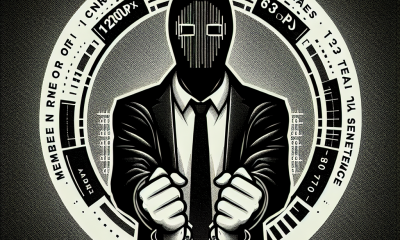Ethereum
SEC Battles to Unseal Ripple’s Financials amid Ongoing Legal Tussle Over XRP

In a legal battle that has captivated the cryptocurrency community, the U.S. Securities and Exchange Commission (SEC) has mounted a compelling argument against Ripple’s bid to keep certain business records under wraps. At the heart of this dispute is Ripple’s motion to seal and redact financial and institutional sales data submitted in the remedies briefing, a move the SEC staunchly opposes. The regulatory body’s insistence on disclosure underscores the high stakes involved, particularly concerning Ripple’s business operations and the broader implications for the crypto market’s regulatory landscape.
Ripple, a prominent player in the cryptocurrency world known for its XRP token, sought to shield details including financial reports and information regarding XRP sales to institutional investors post-complaint. The company cited significant risks to its operations as the rationale behind its request for confidentiality. However, the SEC’s counter-argument, filed in response to Ripple’s motions on May 21st, challenges the premise that such information should be kept from the public eye.
Highlighting the principle of transparency, the SEC emphasized the importance of making Ripple’s financial dealings, including sales figures and revenue details, accessible. These records, the SEC argues, are vital to assessing the appropriate remedies and understanding the extent of investor harm. Moreover, the SEC pointed out that certain information Ripple seeks to protect is either already public or outdated, hence not justifying the need for sealing. Ripple’s previous success in sealing similar data does not, in the SEC’s view, warrant a continuation of the practice, especially when weighed against the public’s right to information.
Adding another layer to this complex legal tussle is the market reaction to the ongoing lawsuit. Ripple’s XRP token experienced a notable uptick in price, surging by roughly 5% within a 24-hour window, albeit with analysts cautioning about the potential for sustained lower trading levels amid regulatory uncertainties. The rally in XRP’s price coincides with increased trading activity and a broader optimism in the cryptocurrency market, fueled in part by speculation surrounding the approval of a spot ethereum ETF.
However, amidst these financial machinations, there’s conspicuous whale activity, with significant XRP holdings being moved. This development signifies the high level of attention the lawsuit has garnered from large-scale investors and the crypto community at large. It highlights the broader market sensitivities to major regulatory actions and legal battles within the sector.
The unfolding legal battle between Ripple and the SEC is emblematic of the growing pains of a maturing cryptocurrency market facing regulatory scrutiny. The SEC’s push for transparency in the Ripple case not only highlights the regulatory challenges facing crypto enterprises but also sets a precedent for how similar cases might be handled in the future. As the lawsuit progresses, the outcome could have far-reaching implications for the regulatory landscape of the digital currency world, potentially influencing the disclosure practices and operational transparency of crypto entities.
The crypto community and investors are closely watching this case, as its outcome could influence the regulatory framework and operational standards within the cryptocurrency industry. As Ripple and the SEC continue their legal skirmish, the broader implications for market transparency, investor protection, and regulatory engagement with the crypto sector remain key points of interest.
Bitcoin
Cardano Community to Govern $681 Million Treasury Amidst Historic Chang Fork Upgrade

The Cardano community stands at the brink of a new era with the impending Chang Fork, transitioning into what is being hailed as the “Age of Voltaire.” This crucial step will thrust upon its members governance over an impressive treasury amassing over $683 million, elevating its status to possess the eighth-largest treasury within the cryptocurrency sphere. The accumulation of these funds, sourced from transaction fees and block rewards, earmarks a significant shift towards self-sustainability and fosters further development within the Cardano ecosystem.
In stark contrast to its contemporaries, Cardano’s treasury is unique, consisting solely of ADA tokens. This sets it apart from the norm observed in other blockchain protocols that diversify their treasury assets across stablecoins and notable cryptocurrencies such as bitcoin and ethereum. This strategic decision reflects Cardano’s commitment to its native token and the vision of its future.
The Cardano project, underpinned by a strategic roadmap, operates through a tripartite governance structure which includes the Cardano Foundation, Input Output Global (IOG), and EMURGO. These entities synergize efforts in development, research, and commercial activities, laying the groundwork for the treasury’s management. The proposed Chang Fork, a significant upgrade, will catalyze the shift towards a decentralized model for the blockchain ecosystem, marking it as an unprecedented milestone in Cardano’s journey and the broader industry.
Charles Hoskinson, the founder of Cardano, encapsulated the significance of this transition, envisioning a decentralized civilization that spans across the globe, powered by a complex governance system. Supported by an annual budget and the collective wisdom of the Cardano community, this evolution promises to introduce a highly advanced framework for blockchain governance. Hoskinson’s ambitions for Cardano extend far beyond technological innovation, fostering a global community bound by shared goals and collective decision-making processes.
The Chang Fork represents the culmination of a long-term vision for Cardano, transitioning control over to its community. This evolution will activate voting and treasury systems, enabling ADA holders to propose and pass resolutions on significant improvements and innovations. By empowering its network participants through an inclusive governance model via staking and delegation, Cardano embarks on achieving a significant degree of self-sustainability. This process not only democratizes innovation within the ecosystem but also ensures that the development trajectory aligns with the community’s aspirations.
Cardano’s roadmap and the Chang Fork initiative highlight the project’s commitment to a decentralized and inclusive model. With a focus on empowering its community members and fostering ecosystem development, Cardano is poised to set new standards in blockchain governance and operational sustainability. As it transitions into the Age of Voltaire, Cardano’s vision of a decentralized civilization seems increasingly attainable, promising a new chapter in the cryptocurrency domain marked by innovation, engagement, and collective progress.
Bitcoin
Revolution in Investment: Real-World Asset Tokenization Sector Surges Ahead of Ethereum and Bitcoin

In a remarkable surge within the cryptocurrency sector, the tokenization of real-world assets (RWA) has prominently emerged as the leader, eclipsing the performance of giants such as ethereum (eth) and bitcoin (btc). This ascendancy is powered by high-profile asset tokenizations and a positive regulatory landscape, showcasing the sector’s burgeoning potential and growing significance in the financial industry.
The sector’s remarkable performance is partly attributable to significant strides in high-profile use cases and regulatory advancements. For instance, on June 4, Galaxy Digital executed a multimillion-dollar loan secured by a 316-year-old Stradivarius violin, using its digital representation as a non-fungible token (NFT) for collateral. This innovative use case not only ensured strong security for Galaxy Digital but also illustrated the flexibility and potential of asset management through tokenization. The physical violin, secured and monitored under strict conditions in Hong Kong, demonstrates a tangible bridge between traditional assets and digital futures.
On the same note, Watford Football Club ventured into digital equity, offering approximately 11% of its shares in collaboration with digital investment platforms Republic and Seedrs. Such initiatives not only bring traditional assets into the digital ecosystem but also open new avenues for investment and ownership democratization.
Regulatory developments have also shown support for the burgeoning sector. A pivotal hearing titled “Next Generation Infrastructure: How Tokenization of Real-World Assets Will Facilitate Efficient Markets” was held on June 7 by the US Financial Services Committee. This forum brought together a diverse group of industry leaders and experts, ranging from Carlos Domingo, Co-founder and CEO of Securitize, to representatives from the financial markets sector and academia. Their discussions underscored the ongoing debate surrounding blockchain technology’s integration into traditional finance, indicating a move towards regulatory clarity and broader adoption of tokenization technologies.
The sentiment within the sector remains optimistic for the long-term. Prominent figures like BlackRock CEO Larry Fink have voiced their confidence in tokenization, emphasizing its potential to revolutionize investment strategies through instantaneous bond and stock settlements, thus significantly reducing settlement costs. Similarly, Jenny Johnson, CEO of Franklin Templeton, pointed out the transformative capability of RWA tokenization, from offering NFT-based Rihanna royalties to integrating loyalty programs with tangible assets. This perspective aligns with Johnson’s view on leveraging technology to merge traditional assets with blockchain, enhancing accessibility for younger investors and promoting a culture of saving and investment through digital wallets.
The embracing of RWA tokenization by traditional financial institutions is seen as a pivotal movement towards democratizing investment opportunities and fostering financial inclusion. Johnson’s insights highlight how reduced entry points and operational costs associated with tokenized assets could encourage more inclusive savings and investment practices, particularly among younger demographics. As traditional and digital financial realms converge, RWA tokenization stands as a beacon for the future of finance, weaving together technological innovation with the fabric of conventional asset management to pave the way for a more accessible and efficient financial ecosystem.
In essence, the rise of RWA tokenization not only exemplifies the dynamic and evolving nature of the cryptocurrency sector but also signals a broader trend towards integrating blockchain technology into mainstream financial practices. This integration promises to revolutionize asset management and investment, offering a more inclusive, efficient, and secure platform for investors and stakeholders across the globe.
Bitcoin
Over $2.2 Billion in Bitcoin and Ethereum Options Set to Expire, Market Braces for Volatility

The cryptocurrency market is on the edge of experiencing a period of potentially heightened volatility, with a whopping $2.25 billion worth of bitcoin (btc) and ethereum (eth) options poised to expire. This massive expiration could significantly influence the volatility and pricing of these two leading digital currencies, creating a ripple effect throughout the marketplace.
In a detailed examination, it emerges that Bitcoin options contracts valued at approximately $1.26 billion and Ethereum options contracts worth roughly $996 million are set to expire. The reaction of traders to this impending expiration holds the potential to either spark a new wave of sell-offs or generate increased buying pressure, depending on their strategic decisions and market sentiment.
Data from Deribit highlights the expiration of 17,609 Bitcoin contracts with a put-to-call ratio of 0.67, indicating a stronger inclination towards purchase options (calls) over sales options (puts). This preference suggests that many traders might be betting on the future appreciation of Bitcoin’s value.
A close look at the options market reveals Bitcoin’s maximum pain point is currently around $71,250, a critical level where the asset could inflict the maximum financial pain on the highest number of option holders. This concept of the ‘maximum pain point’ is significant in options trading, offering insights into potential market movements as prices tend to gravitate towards these levels at option expiration.
Despite the looming options expiration, analysts from crypto option trading tools provider Greeks.Live have offered a rather optimistic perspective for the prices of Bitcoin and Ethereum. They observe that the crypto market, especially Bitcoin, has demonstrated resilience and strength in light of recent financial developments, including interest rate cuts by significant banking institutions like the Bank of Canada (BOC) and the European Central Bank (ECB). Their analysis suggests that the U.S. Non-Farm Payrolls and Unemployment Rate data, coupled with expectations of a Federal Reserve rate cut, have injected a measure of volatility and bullish sentiment into the macro trading environment.
On Ethereum’s side, a total of 260,341 contracts are up for expiration, with a put-to-call ratio standing at 0.64. Ethereum’s maximum pain point is identified at $3,675, providing another focal point for traders and analysts to gauge market sentiments and potential price movements closely.
Even as these option expirations pose a temporary disruption in the market, they often lead to eventual stabilization. Traders are advised to maintain vigilance, employing a strategic approach by closely analyzing technical indicators and market sentiment. This proactive stance will be crucial in navigating through the anticipated market volatility efficiently.
As the trading week comes to a close, both Bitcoin and Ethereum have demonstrated notable resilience amid these market dynamics. Bitcoin surged to a two-month peak of $71,913 before experiencing a slight pullback, while Ethereum has been trading at $3,825 after a minor correction. These movements underscore the fluid and dynamic nature of the cryptocurrency market, especially in response to significant option expiry events and macroeconomic indicators.
The recent developments within the cryptocurrency market, highlighted by the massive options expiration, provide a vivid snapshot of the intricate interplay between market sentiment, financial indicators, and macroeconomic events. As the market continues to evolve, traders and investors alike will need to stay informed and adaptable to navigate through these turbulent waters effectively.
-

 Cryptocurrency1 month ago
Cryptocurrency1 month agoExploring the Future of Finance: Regulated Settlement Network PoC Aims to Unify Banking and Securities on a Single Platform
-

 Cryptocurrency2 months ago
Cryptocurrency2 months agoProtocol Village Announces ‘Expander’: An Open-Source ZK Proof System Doubling Speed Compared to Competitors
-

 Cryptocurrency2 months ago
Cryptocurrency2 months agoDr. Ted Kaouk Named Inaugural Chief AI Officer by CFTC
-

 Altcoins2 months ago
Altcoins2 months agoForecasting the Future of Shiba Inu (SHIB) Prices: Heading for a Rally or a Downturn?
-

 Cryptocurrency1 month ago
Cryptocurrency1 month agoOpenAI Gears Up for Exciting ChatGPT Update: New Features and Potential Pricing Changes on the Horizon
-

 Memecoins2 months ago
Memecoins2 months agoTop Cryptocurrencies Poised for Growth in 2024
-

 Cryptocurrency2 months ago
Cryptocurrency2 months agoFederal Reserve Maintains Current Policy, Notes Stagnation in Inflation Progress
-

 Cryptocurrency2 months ago
Cryptocurrency2 months agoMember of REvil Ransomware Syndicate, Rabotnik, Receives 13-Year Jail Sentence



